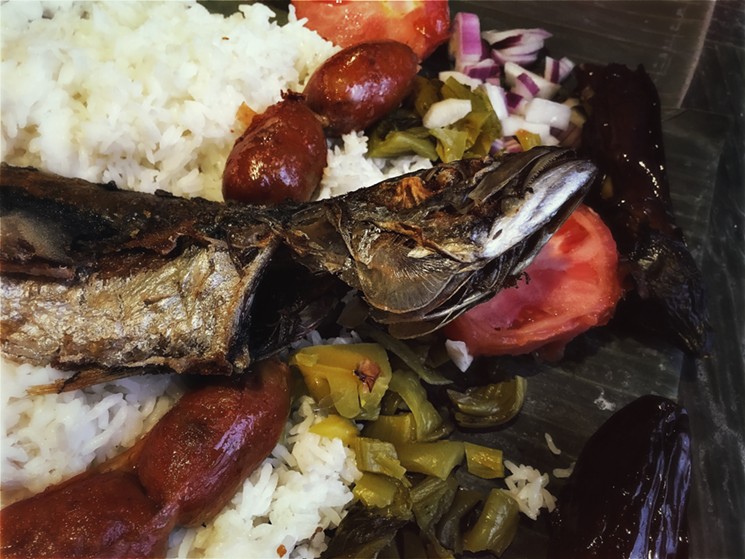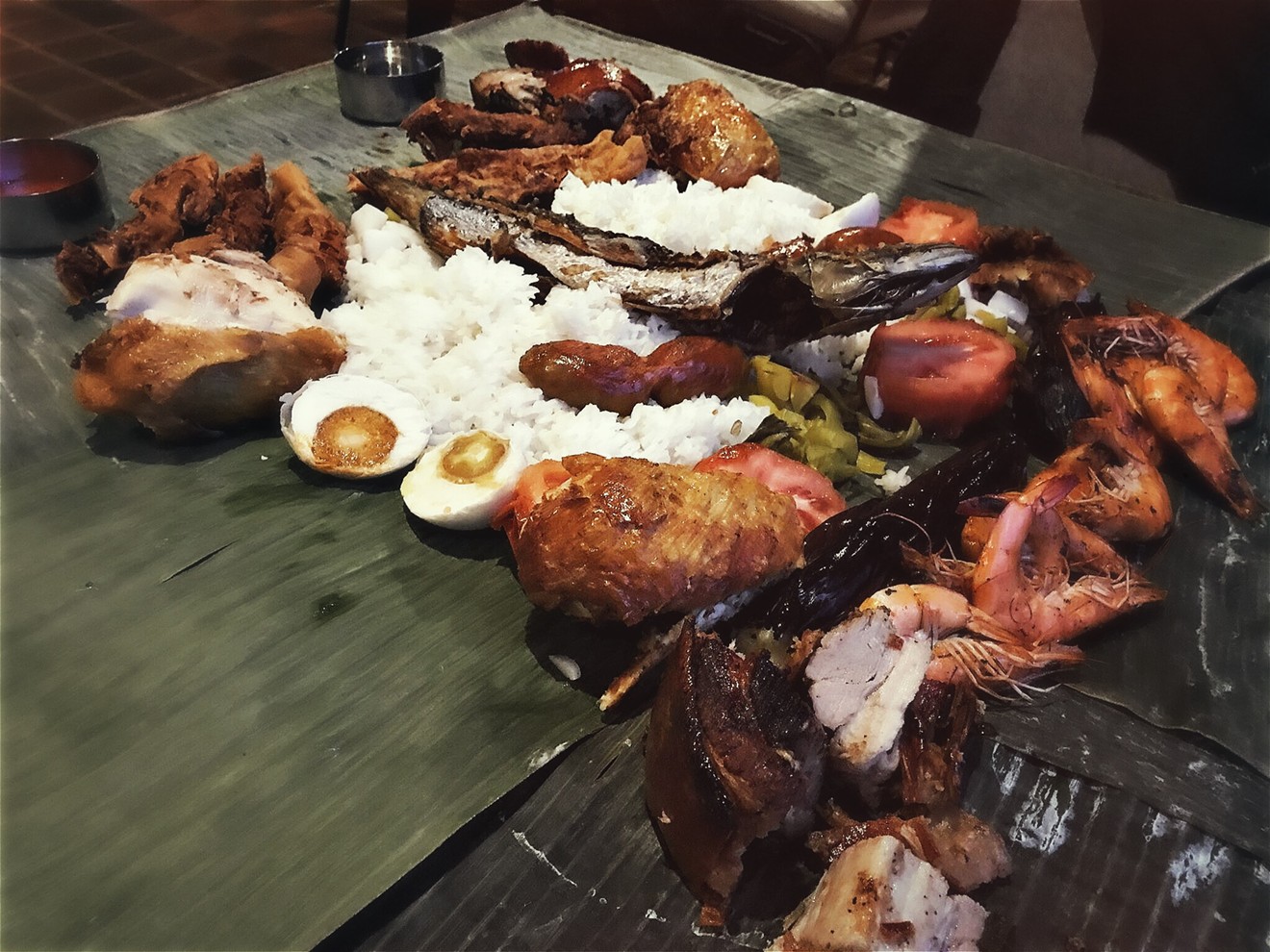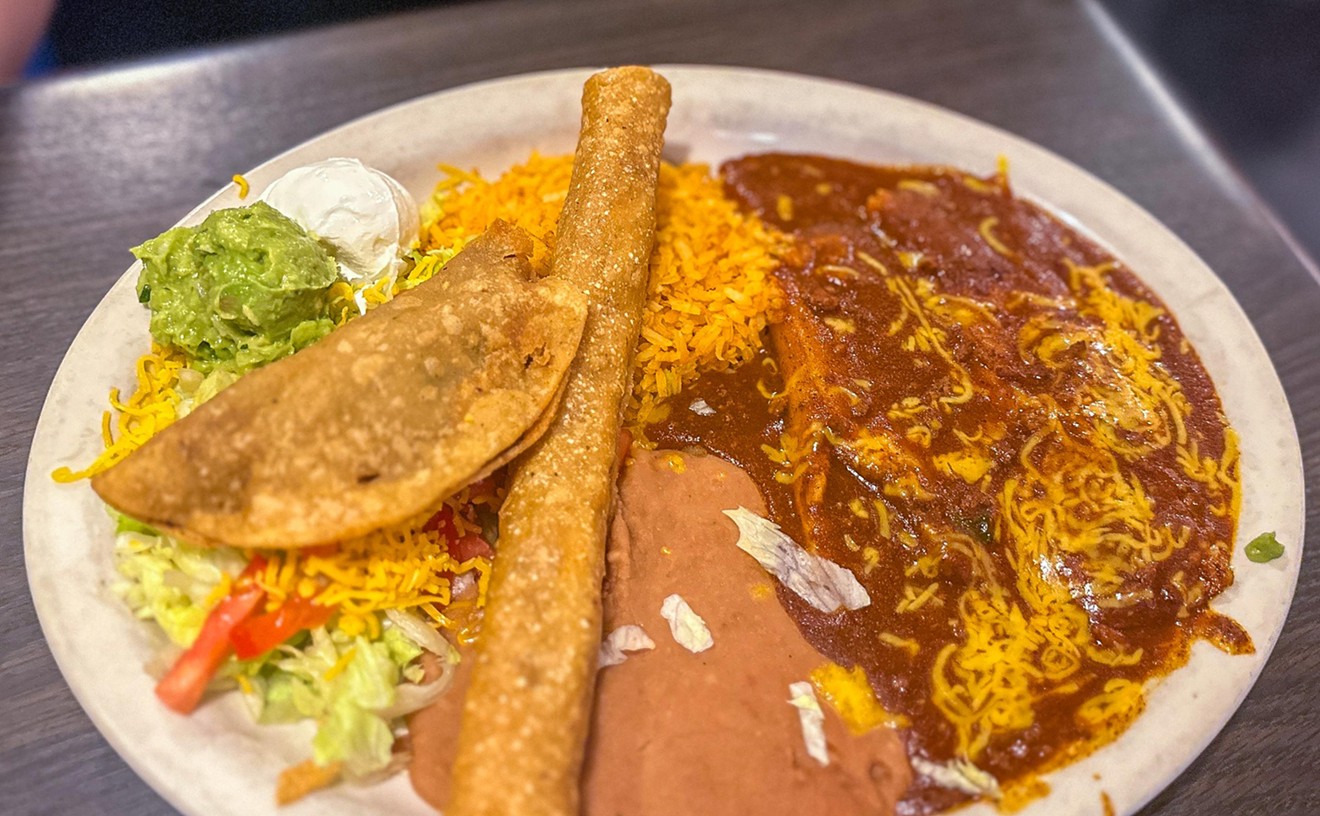A Gamatan (or Kamayan) dinner is a traditional Filipino feast offering an assortment of seafood, meats and vegetables served communally atop a banana leaf-covered table — no plates, no utensils, no napkins, just food. If that sounds like a traditional Southern crawfish boil, it's because the experiences are quite similar. You eat with your hands, and you eat until you hurt.
Owner Roland Miranda has been fine-tuning his version of Gamatan through a series of pop-ups over the past year in an attempt to prove to himself, and more importantly, prove to his wife, that opening a brick-and-mortar restaurant specializing in Filipino cuisine could be a viable business model in DFW. He and wife Trisha opened Koya’s Place in early February and are serving traditional Filipino cuisine from Pampanga, the culinary capital in the Philippines. Last weekend, they hosted Koya’s grand opening, launching their full menu and offering a limited seating, reservation-only Gamatan.
Located in the upper level of a nondescript Richardson strip mall, the space itself still needs a little polishing, but the kitchen is fully functioning and there are places to sit, which is all you really need. Sitting down to eat felt less like dinner out at a new restaurant and more like dining in someone’s home soon after they’d moved in.
“It’s never going to be fine food when you come here,” Roland says. “I’m no chef; I’m a home cook.”
But that home-cooked aspect lends to the appeal. A number of diners at the grand opening enjoyed the experience precisely because they were eating foods familiar from their childhoods. One diner pointed to the longanisa, chubby Pampanga-style pork sausages, remarking that “my mom used to make those for me for breakfast.”
The menu promises a few dishes that are near-impossible to come by in DFW, like balut, an 18-day-old fermented duck embryo that’s boiled and eaten in the shell. It’s a popular street food in the Philippines, but Roland says he’ll only serve it if the request is legitimate, and not “a Fear Factor thing.” The menu doesn’t even include a description of the polarizing dish, claiming “no description necessary.” Ordering the appetizer as a dare would be in poor taste. “I respect this food,” Roland says. “It’s not a joke; it’s not a punchline.”

A whole fried red snapper, longanisa sausage, pickled cabbage, charred Japanese eggplant, grilled tomatoes. Just a small portion of a much larger meal.
Courtney Jacobs
“My lumpia are ugly,” Roland admits, referring to the jagged and uneven wrappers. “I can’t make a pretty lumpia because if they’re pretty they fall apart.” In reality, this means the entire lumpia is crunchy, not just the ends like a standard egg roll, so that’s a win.
After the lumpia come the big guns: a dozen head-on gulf shrimp, an entire fried snapper, half a roasted chicken with impossibly crispy skin, and last (but certainly not least), the lechon, a whole sucking pig that’s been slow-roasted for hours until it’s a fatty, crackling hunk of heaven. Think pork tenderloin wrapped in a pork chop wrapped in pork belly that's wrapped in half-inch-thick crispy bacon.
Though there are some vegetables to be found, Gamatan is primarily a showcase for impressive meats, and Koya’s nails every one. Roland admits he’s proudest of his lechon, which is understandable since it is widely considered the national dish of the Philippines. A good lechon is an impressive feat for a home chef, and Rolan’s lechon is carnal, thick pig skin shattering as you bite into a hunk of layered, fatty pork. This stuff is addicting.
If you head out to Richardson soon expecting a Gamatan, make sure you make a reservation first; they (understandably) won’t be able to accommodate walk-ins. If you’re unfamiliar with the experience and want a few pointers, here are some tips for getting the most out of your Filipino feast:
Be patient. You won’t understand until it arrives, but a Gamatan feast is roughly seven separate meals in one. It must be a nightmare for the kitchen to cook and prep all that food for service. We waited almost half an hour from the time we were seated before we saw any food, and it was another 20 before all the components were served. A number of the items come out in shifts, piled on top of the banana leaves and rice mounds like an edible Kandinsky, the entire meal built up with each addition into an unreal mountain of food. So be patient, be kind and for the love of all that’s holy, be prepared.
Be messy. Gamatan is a full contact sport. The word Kamayan literally means “shake hands,” but is also used to denote other actions performed with one’s bare hands, so a Kamayan dinner (or Gamatan for those in the States) is meant to be consumed with bare hands. Not only are utensils forbidden but napkins are also against the rules, though we were granted special permission for note taking. To get the full experience, diners should take the advice to literally dig in. Peel the heads off shrimp, carve crispy chunks of fish off the bone, crack open the hunks of roasted pork, and mash finger-fulls of warm rice into the resulting flavors pooling onto the banana leaves. Envision your hand as a built-in spork, and you’re good to go.
Be prepared to karaoke. From the moment you arrive to the moment you leave, the servers will politely suggest you partake in the time-honored Filipino custom of karaoke. The somewhat low-tech setup is laid out in the center of the dining room, just outside the kitchen, so you can see what everyone else ordered before they do while belting out your best rendition of “Billie Jean.”
Be hungry. A Gamatan feast is an unholy amount of food. Our Gamatan for two included four longanisa sausages, four pork lumpia, a whole grilled tomato, two salted eggs, a dozen shrimp, half of a chicken, an entire fried snapper and several giant chunks of lechon, all served atop what was easily an entire quart of rice — and, incredibly, Gamatan for two will only set you back $55. We ate for over an hour, until we could barely move, and still took home four full-sized containers for later.
Be a tortoise, not a hare. With this much food, it’s best to pace yourself. The food comes in shifts; portion after portion piling up until you’re faced with your own private mountain of food. Don’t go all out in the beginning only to wind up too full for the finale.
BYOB. Koya’s doesn’t currently have a license to sell alcohol, so you should bring your own if you wish to imbibe with your meal. If you want to stick with tradition, get your hands on a sixer of Red Horse, an extra-strong lager brewed in the Philippines. Otherwise, any inexpensive pale lager should pair well with your meal. Your server can provide you with a bottle opener and even cut your lime into wedges if you ask nicely.
Koya’s Place, 300 N. Coit Road Suite 270, Richardson











